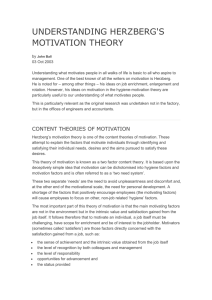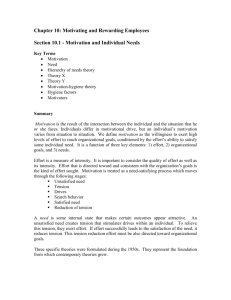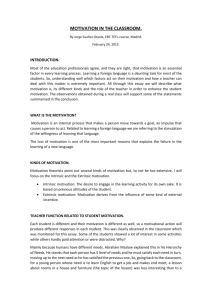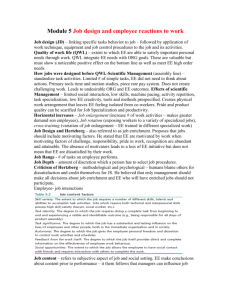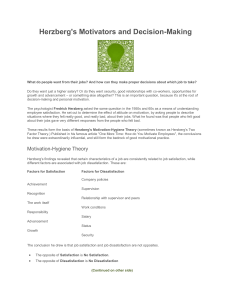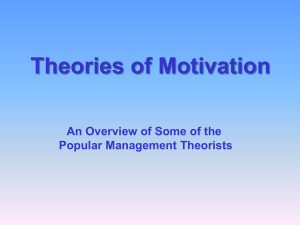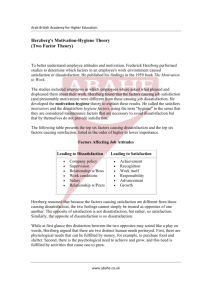Frederick Hertzberg's Hygiene Motivation Theory explained
advertisement
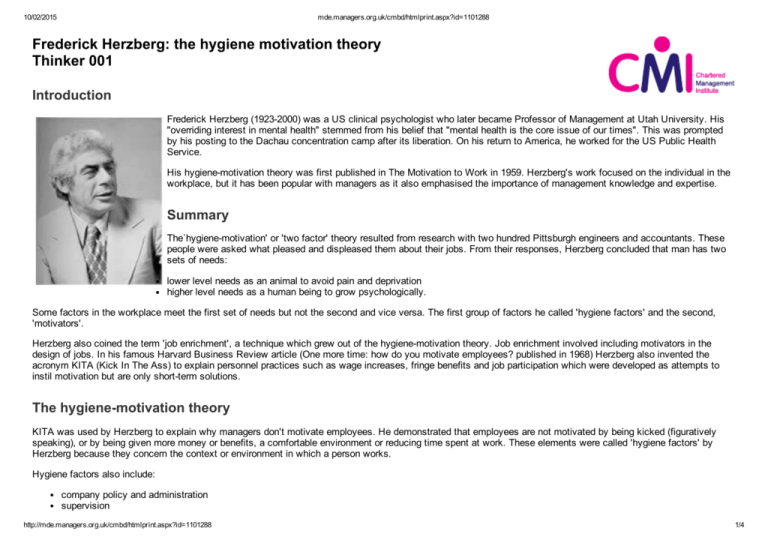
10/02/2015 mde.managers.org.uk/cmbd/htmlprint.aspx?id=1101288 Frederick Herzberg: the hygiene motivation theory Thinker 001 Introduction Frederick Herzberg (1923­2000) was a US clinical psychologist who later became Professor of Management at Utah University. His "overriding interest in mental health" stemmed from his belief that "mental health is the core issue of our times". This was prompted by his posting to the Dachau concentration camp after its liberation. On his return to America, he worked for the US Public Health Service. His hygiene­motivation theory was first published in The Motivation to Work in 1959. Herzberg's work focused on the individual in the workplace, but it has been popular with managers as it also emphasised the importance of management knowledge and expertise. Summary The`hygiene­motivation' or 'two factor' theory resulted from research with two hundred Pittsburgh engineers and accountants. These people were asked what pleased and displeased them about their jobs. From their responses, Herzberg concluded that man has two sets of needs: lower level needs as an animal to avoid pain and deprivation higher level needs as a human being to grow psychologically. Some factors in the workplace meet the first set of needs but not the second and vice versa. The first group of factors he called 'hygiene factors' and the second, 'motivators'. Herzberg also coined the term 'job enrichment', a technique which grew out of the hygiene­motivation theory. Job enrichment involved including motivators in the design of jobs. In his famous Harvard Business Review article (One more time: how do you motivate employees? published in 1968) Herzberg also invented the acronym KITA (Kick In The Ass) to explain personnel practices such as wage increases, fringe benefits and job participation which were developed as attempts to instil motivation but are only short­term solutions. The hygiene­motivation theory KITA was used by Herzberg to explain why managers don't motivate employees. He demonstrated that employees are not motivated by being kicked (figuratively speaking), or by being given more money or benefits, a comfortable environment or reducing time spent at work. These elements were called 'hygiene factors' by Herzberg because they concern the context or environment in which a person works. Hygiene factors also include: company policy and administration supervision http://mde.managers.org.uk/cmbd/htmlprint.aspx?id=1101288 1/4 10/02/2015 mde.managers.org.uk/cmbd/htmlprint.aspx?id=1101288 working relationships status and security. These factors do not in themselves promote job satisfaction, but serve primarily to prevent job dissatisfaction, just as good hygiene does not in itself produce good health, but lack of it will cause disease. Herzberg also speaks of them as dissatisfiers or maintenance factors, since it is their absence or inadequacy which causes dissatisfaction at work. Some factors are not true motivators as they need constant reinforcement. Additionally, they increasingly come to be regarded as rights to be expected, rather than incentives to greater satisfaction and achievement. 'Motivators' (also referred to as growth factors) relate to what a person does at work, rather than to the context in which it is done. They include: achievement recognition the work itself responsibility advancement and growth. Herzberg explains that the two sets of factors are separate and distinct because they are concerned with two different sets of needs. They are not opposites. Herzberg's hygiene­motivation theory is derived from the outcomes of several investigations into job satisfaction and job dissatisfaction, studies which replicated his original research in Pittsburgh. The theory proposes that most factors which contribute to job satisfaction are motivators (achievement, recognition, the satisfaction of the work itself, responsibility and opportunities for advancement and growth) and most factors which contribute to job dissatisfaction are hygiene elements (company policy, general management, the individuall relationship with their manager and working conditions). Most of the evidence on which Herzberg based his theory is relatively clear­cut. This is particularly the case with regard to achievement and promotion prospects as potential job satisfiers and with regard to supervision and job insecurity as factors which contribute principally to dissatisfaction. The element which continues to cause some debate is salary/pay, which seems split down the middle. Herzberg's evidence was not so clear here, although he placed salary with the disatissfiers. This would seem the most appropriate classification; although pay may have some short­term motivational value, it is difficult to conceive of it as a long­term motivator in the same manner as responsibility and achievement. Most experience (and the history of industrial relations) would point to pay as a dissatisfier and therefore a hygiene factor along with supervision, status, and security. Herzberg used biblical allusions to illustrate his theory. He depicted man's basic needs as two parallel arrows pointing in opposite directions. One arrow shows man's Animal­Adam nature, concerned with the need to avoid physical deprivation (the hygiene factors), the other his Human­Abraham nature, needing to realise the potential for perfection (the motivation factors). Job enrichment was an extension of Herzberg's hygiene­motivation theory. He saw it as a continuous management function which involved embracing motivators in job design. These included: self­scheduling control of resources accountability and undertaking specialised tasks to become expert in them. http://mde.managers.org.uk/cmbd/htmlprint.aspx?id=1101288 2/4 10/02/2015 mde.managers.org.uk/cmbd/htmlprint.aspx?id=1101288 Herzberg in perspective Herzberg's ideas have proved very durable. A late 1990s article, for example, draws on his classic 1968 Harvard Business Review article, and adapts his 'hygiene' and 'satisfier' factors to apply them to customer satisfaction (Naumann and Jackson, 1999). His work can be seen ­ in common with that of Elton Mayo (known for the Hawthorne Experiments), of Abraham Maslow (developer of the hierarchy of needs) and of Douglas McGregor (creator of Theory X and Theory Y) ­ as a reaction to F W Taylor's Scientific Management theories. These last focused on techniques which could be used to maximise the productivity of manual workers and on the separation of mental and physical work between management and workers. In contrast, Herzberg and his contemporaries believed that workers wanted the opportunity to feel part of a team and to grow and develop. Although Herzberg's theory is not highly regarded by psychologists today, managers have found in it useful guidelines for action. Its basic tenets are easy to understand and can be applied to all types of organisation. Furthermore, it appears to support the position and influence of management. More specifically, its impact has been seen on reward systems, firstly in a move away from payment­by­results systems and today in the growing proportion of cafeteria benefits schemes, which allow individual employees to choose the fringe benefits which best suit them. Job enrichment was more theorised about than put into practice. Many schemes which were tried resulted only in cosmetic changes or led to demands for increased worker control and were therefore terminated. Nowadays the concept is more one of people enrichment, although this still owes much to Herzberg's original work. His greatest contribution has been the knowledge that motivation comes from within the individual; it cannot be imposed by an organisation according to some formula. Many of today's trends ­ career management, self­managed learning, and empowerment ­ have a basis in Herzberg's insights. Key works by Herzberg The editions cited here, which may not always be the first edition, are those held in, and available for loan to members in the UK from, the CMI Library. Books Work and the nature of man London: Staples Press, 1968 The managerial choice: to be efficient and to be human Homewood, Ill: Dow Jones­Irwin, 1976 The motivation to work, 2nd edition, with Bernard Mausner and Barbara Bloch Snyderman New York: John Wiley, 1959 Journal article One more time: how do you motivate employees? Harvard Business Review, vol 46 no 1, Jan/Feb 1968, pp53­62 This article was republished (Harvard Business Review, vol 65 no 5, Sep/Oct 1987, pp109­120) with a retrospective commentary by the author. By the time of its reprint in 1987, this article had sold over one million reprints, making it the most requested article in the Harvard Business Review's history. http://mde.managers.org.uk/cmbd/htmlprint.aspx?id=1101288 3/4 10/02/2015 mde.managers.org.uk/cmbd/htmlprint.aspx?id=1101288 Further reading One more time ­ how do you satisfy customers? Earl Naumann and Donald W. Jackson Business Horizons, vol 42, no 3, May/Jun 1999, pp71­76 Herzberg ­ still a key to understanding motivation, Donald Cameron Training Officer, vol 32 no 6, Jul/Aug 1996, pp184­186 Leadership and motivation: the fifty fifty rule and the eight key principles of motivating others, John Adair, London: Kogan Page, 2009 Text revised June 2003 Further reading updated January 2012 This publication is for general guidance only. The publisher and expert contributors disclaim all liability for any errors or omissions. You should make appropriate inquiries and seek appropriate advice before making any business, legal or other decisions. Where legal or regulatory frameworks or references are mentioned these relate to the UK only. To make an enquiry about ManagementDirect, post suggestions or report a problem with the product email ManagementDirect support at managementdirect@managers.org.uk or contact the ManagementDirect enquiry line on +44 (0)1536 207290. http://mde.managers.org.uk/cmbd/htmlprint.aspx?id=1101288 4/4
